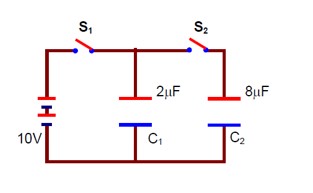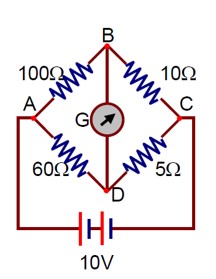Class 12th
Get insights from 12k questions on Class 12th, answered by students, alumni, and experts. You may also ask and answer any question you like about Class 12th
Follow Ask QuestionQuestions
Discussions
Active Users
Followers
New answer posted
2 months agoContributor-Level 10
Electric field squared is proportional to the power P of the bulb (E² ∝ P).
(E' / E)² = (60 / 100) ⇒ E' = E * √* (3/5)*
New answer posted
2 months agoContributor-Level 9
Power gain = (i_c² R_c) / (i_b² R_B) = (i_c/i_b)² (R_c/R_B) = (10²)² (10? /10³) = 10?
i_c/i_b = 100 ⇒ β = i_c/i_b = 100
New answer posted
2 months agoContributor-Level 9
T = 2π√ (l/g) ⇒ g = 4π²l/T²
Percentage error: Δg/g = Δl/l + 2 (ΔT/T) = (0.1/10.0) + 2 (0.005/0.5) = 0.03
Percentage error = (Δg/g) * 100 = 3%
ω = 2πf = 100π rad/s
i_rms = i? /√2
While current changes from its maximum to its rms value, its phase changes by π/4 rad.
t = (π/4)/ω = π/ (4 * 100π) = 2.5 * 10? ³ s = 2.5ms.
New answer posted
2 months agoContributor-Level 10
Let the equation of the plane passing through (1, 2, 3) be:
a (x - 1) + b (y - 2) + c (z - 3) = 0
The plane contains the y-axis, which has direction ratios (0, 1, 0).
Therefore, the normal to the plane must be perpendicular to the y-axis.
a (0) + b (1) + c (0) = 0 ⇒ b = 0
The equation becomes: a (x - 1) + c (z - 3) = 0
ax + cz = a + 3c
The plane also passes through the origin (0,0,0) since it contains the y-axis.
a (0) + c (0) = a + 3c ⇒ a + 3c = 0 ⇒ a = -3c
Substitute a = -3c into the plane equation:
-3c (x - 1) + c (z - 3) = 0
-3 (x - 1) + (z - 3) = 0
-3x + 3 + z - 3 = 0
-3x + z = 0 ⇒ 3x - z = 0
New answer posted
2 months agoContributor-Level 10
Given the refractive index μ = λ? / λ = 3/2 and v = 10m, the object distance is u = - (3/2)v = -15m.
Using the lens maker's formula:
μ/v - 1/u = (μ - 1)/R
(3/2)/10 - 1/ (-15) = (3/2 - 1)/R
This gives the radius of curvature R:
R = -30/13 m
New answer posted
2 months agoContributor-Level 9
Resonance frequency is independent of R.
Quality factor = ωL/R ⇒ Quality factor decreases with increase in R.
Bandwidth of resonance circuit = R/L ⇒ increases with increase in R.
New answer posted
2 months agoContributor-Level 10
Let the charge on C? be q µC. For the capacitor network:
q/C? = (C? * 10 - q) / C? ⇒ q/8 = (2 * 10 - q) / 2 ⇒ q = 16
New answer posted
2 months agoContributor-Level 9
λ? /λ? = (m? v? ) / (m? v? ) ⇒ m? = m? (v? /v? ) (λ? /λ? ) = m? (1/4) (1/2) = (1/8)m?
New answer posted
2 months agoContributor-Level 10
The system of equations has no solution if the determinant of the coefficient matrix is zero.
Δ = |k 1|
|1 k 1|
|1 k|
Δ = k (k² - 1) - 1 (k - 1) + 1 (1 - k) = 0
Δ = k³ - k - k + 1 + 1 - k = 0
⇒ k³ - 3k + 2 = 0 ⇒ (k - 1)² (k + 2) = 0
∴ k = -2, 1
If k = 1 then all the equations are identical (infinite solutions). Hence k = -2 for no solution.
New answer posted
2 months agoContributor-Level 10
Let V? = 10V, V? = xV, V? = 0V, and V? = yV.
Applying Kirchhoff's current law at node B:
(x - 10)/100 + (x - y)/15 + (x - 0)/10 = 0 ⇒ 53x - 20y = 30 . (1)
Applying Kirchhoff's current law at node D:
(y - 10)/60 + (y - x)/15 + (y - 0)/5 = 0 ⇒ 17y - 4x = 10 . (2)
Solving equations (1) and (2), we get:
x = 0.865 and y = 0.792
The current i? is:
i? = (x - y) / 15 = 4.87 mA
Taking an Exam? Selecting a College?
Get authentic answers from experts, students and alumni that you won't find anywhere else
Sign Up on ShikshaOn Shiksha, get access to
- 65k Colleges
- 1.2k Exams
- 679k Reviews
- 1800k Answers


